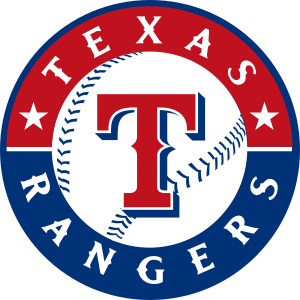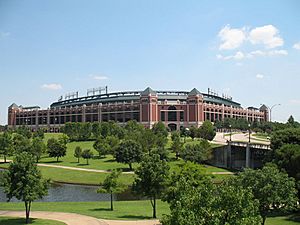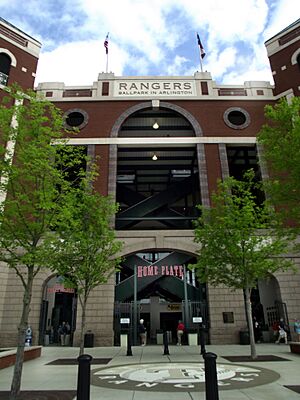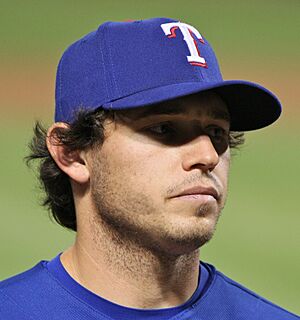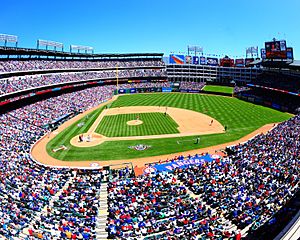History of the Texas Rangers (baseball) facts for kids
The Texas Rangers are a professional baseball team in Major League Baseball (MLB). The team started in 1961 as the Washington Senators in Washington, D.C.. This was a new team created after the old Washington Senators moved to Minnesota and became the Twins. The new Senators played in Washington until 1971.
In 1972, the team moved to Arlington, Texas, and became the Texas Rangers. They played at Arlington Stadium until 1993. A new stadium, The Ballpark in Arlington, opened in 1994. It was later renamed Globe Life Park in Arlington in 2014.
It took the team 36 seasons to reach the playoffs for the first time. Since then, they have made nine playoff appearances. They won their division seven times (1996, 1998, 1999, 2010, 2011, 2015, 2016) and made the playoffs as a wild card team twice (2012, 2023).
In 2010, the Rangers won their first American League pennant by beating the New York Yankees. They played in their first World Series but lost to the San Francisco Giants. The next year, they won the American League pennant again but lost the World Series to the St. Louis Cardinals. In 2023, the team won the 2023 World Series, which was their first championship ever! The Rangers play in the American League West Division with the Oakland Athletics, Seattle Mariners, Los Angeles Angels, and Houston Astros.
Contents
- The Washington Senators Years: 1961–1971
- Becoming the Texas Rangers
- First Years in Texas: 1972–1984
- The Valentine, Ryan, and Bush Years: 1985–1994
- First Success: 1995–2000
- The Lean Years: 2001–2004
- 2005–2009: Rebuilding the Team
- 2010–2016: Rise to Contention
- 2023-Present: The Bruce Bochy Era and First World Series Championship
The Washington Senators Years: 1961–1971

When the first Washington Senators team moved to Minnesota in 1960, Major League Baseball decided to add new teams. They created a new team in Washington, D.C., which also took the name "Senators." This new team is considered an expansion team, meaning it started fresh, and didn't carry over the old team's history. The new Senators began playing in 1961 at Griffith Stadium before moving to District of Columbia Stadium (now Robert F. Kennedy Memorial Stadium).
For most of their time in Washington, the new Senators struggled. They often lost many games each season. Frank Howard, known for hitting very long home runs, was one of their best players. He won two home run titles.

The team had several owners in Washington. In 1968, Bob Short bought the team. He hired Hall of Famer Ted Williams as manager. Williams had never managed before, but he helped the Senators have a good season in 1969. They finished in fourth place, and more fans came to watch their games than ever before in Washington baseball history.
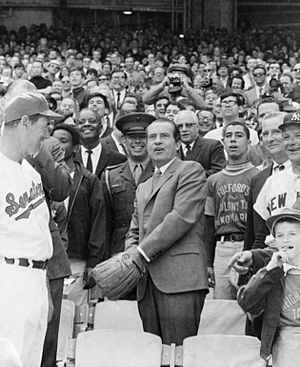
However, this success did not last. Bob Short had borrowed a lot of money to buy the team. He had to make trades that hurt the team to save money. The Senators quickly started losing again. Also, they had to compete for fans with the Baltimore Orioles, who were a very successful team nearby. Fans often chose to watch the Orioles instead. The 1969 season was the only time the team had a winning record in its first 12 years.
By the end of the 1970 season, Short said he would move the team if someone didn't buy it for $12 million. He was interested in an offer from Arlington, Texas, where mayor Tom Vandergriff wanted a Major League team. Arlington had a stadium called Turnpike Stadium, which was built for baseball and could be easily expanded.
After Vandergriff offered a large payment, Short decided to move the team to Arlington. On September 21, 1971, the American League owners approved the move for the 1972 season.
Senators fans were very angry. At the team's last game in Washington, many fans came in without paying. In the ninth inning, with the Senators leading, fans rushed onto the field. They took souvenirs, and one person even ran off with first base! There was no security, so the umpire had to stop the game and give the win to the New York Yankees.
Even after the move, the Rangers kept the rights to the "Senators" name. This meant that when a new team moved to Washington in 2005 (from Montreal), they had to use a different name, the Nationals. However, the Rangers allowed the Nationals to use the "curly W" logo that the expansion Senators had used.
Becoming the Texas Rangers
After moving from Washington, the team was renamed after the Texas Rangers. This is a famous law enforcement agency in Texas, founded in 1823. Their stories inspired characters like The Lone Ranger.
First Years in Texas: 1972–1984
Turnpike Stadium was improved and reopened as Arlington Stadium for the 1972 season. The team played its first game as the Texas Rangers on April 15, 1972, losing 1–0. The next day, they won their first game, 5–1. After the season, manager Ted Williams retired. Whitey Herzog became the new manager, but he was replaced by Billy Martin in 1973.
In 1974, the Rangers started to play much better. They finished second in their division with an 84–76 record. This was amazing because they had lost over 100 games in the two seasons before! Mike Hargrove won Rookie of the Year, Billy Martin was Manager of the Year, and Jeff Burroughs was the American League MVP. Pitcher Ferguson Jenkins won 25 games, which is still a club record. However, after a slow start in 1975, Martin was fired.
The Rangers had good seasons from 1977 to 1979. In 1981, they almost made the playoffs but lost a key game just before a players' strike. After 1981, the Rangers didn't have a winning record for five seasons. During this time, they made a trade that many fans disliked. They sent popular catcher Jim Sundberg to the Milwaukee Brewers.
For a few years in Texas, the team had trouble getting fans to come to games. This was partly because the team wasn't always good, and partly because of the very hot summer weather. Arlington Stadium was often one of the hottest stadiums in baseball. Because of the heat, the Rangers started playing most of their games at night, a tradition that continued until the new Globe Life Field opened in 2020.
The Valentine, Ryan, and Bush Years: 1985–1994
Bobby Valentine became the Rangers' manager in 1985. He managed the team for the longest time in its history. In 1986, the Rangers surprised everyone by having a winning season. They finished second in their division, just five games behind the leaders. Many young players like Rubén Sierra and Pete Incaviglia helped the team improve a lot.
In 1989, the Rangers signed 41-year-old star pitcher Nolan Ryan. Ryan achieved many milestones with the Rangers, including his 5,000th strikeout, 300th win, and two more no-hitters before he retired in 1993. With strong hitters like Juan González and a good pitching staff, fans had high hopes. But the team never finished higher than second place, and Valentine was replaced in 1992.
In 1989, oil businessman Eddie Chiles sold the team to a group of investors. This group was led by George W. Bush, who was the son of the U.S. President at the time. Bush became the Managing General Partner of the team.
During his time, the Rangers and the City of Arlington decided to build a new stadium to replace Arlington Stadium. The new stadium, called The Ballpark in Arlington (now Choctaw Stadium), opened in 1994. Arlington residents helped pay for it through a sales tax increase.
Bush left his role with the Rangers when he was elected Governor of Texas in 1994. He later became the 43rd President of the United States in 2000. He is still a big fan of the team.
In 1993, Kevin Kennedy became manager. The 1994 season ended early because of a players' strike. The Rangers were leading their division at the time, so the strike stopped what could have been their first division championship. However, in 1994, pitcher Kenny Rogers pitched the 12th perfect game in Major League history.
First Success: 1995–2000
The year 1995 brought new hope for the Rangers. They had a new ballpark that hosted the All-Star Game. Johnny Oates was hired as manager. In 1996, Oates led the team to their first division championship ever! This was the team's 36th season, and it took them longer than any other team in North American professional sports to reach the playoffs. They lost to the New York Yankees in the playoffs. Oates was named AL Manager of the Year, and Juan González was named AL MVP.
The team had powerful hitters like Iván Rodríguez and Juan González. But they often struggled with pitching. Oates led the team to more division championships in 1998 and 1999. However, in both years, they lost every playoff game to the Yankees. The 1999 team was the last Rangers team to make the playoffs for over ten years.
In 1998, businessman Tom Hicks bought the team for $250 million.
The Lean Years: 2001–2004
The A-Rod Era: 2001–2003
Before the 2001 season, the Rangers signed star player Alex Rodriguez (A-Rod) to a huge contract. It was the biggest deal in baseball history at the time. Many people thought the team spent too much money on one player instead of getting several good players, especially for a team that needed better pitchers. Even though Rodriguez played very well, the Rangers kept losing. Manager Jerry Narron was fired in 2002 and replaced by Buck Showalter.
In 2003, the team finished last in their division for the fourth year in a row. After some disagreements, Rodriguez was traded to the New York Yankees.
In 2009, Rodriguez admitted that he had used performance-enhancing drugs while he was with the Rangers.
2004: A Surprising Season
Before the 2004 season, most people didn't expect the Rangers to do well. But the team surprised everyone! They battled with the Anaheim Angels and Oakland Athletics for first place for most of the season. Players like Mark Teixeira, Alfonso Soriano, Michael Young, and Hank Blalock became some of the best hitters in the league. Young, Blalock, and Soriano were even chosen for the All-Star Game.
In September, the Rangers had a very exciting game against the Oakland Athletics. They were losing in the ninth inning but came back to win 5–4. This win helped them sweep the Athletics and get closer to first place. However, the Rangers lost some of their last games and finished third, just three games out of first.
2005–2009: Rebuilding the Team
2005: Challenges and Changes
In 2005, the Rangers had a tough season with injuries and other problems. Their star pitcher, Kenny Rogers, was suspended for attacking a cameraman.
On October 4, 2005, John Hart stepped down as general manager. Jon Daniels took his place, becoming the youngest general manager in Major League history at 28 years old.
Daniels made many changes to the team. He traded Alfonso Soriano to the Nationals and brought in new pitchers like Vicente Padilla and Kevin Millwood.
2006: Building for the Future
The Rangers finished the 2006 season with a disappointing record. They couldn't keep up with the Oakland Athletics in the second half of the season. The team still needed a stronger pitching staff. Gary Matthews, Jr. and Michael Young represented the Rangers in the All-Star Game. Young was named MVP for hitting a game-winning triple.
After the season, the Rangers fired manager Buck Showalter. They hired Ron Washington to manage the team. The team also made more trades to get new players, focusing on young talent.
In 2004, the ballpark was renamed "Ameriquest Field" after a company bought the naming rights. But in 2007, the Rangers ended that agreement and changed the name back to Rangers Ballpark in Arlington. The team wanted to focus on its own "brand" or identity.
2007–2009: Financial Issues and Young Talent
The Rangers struggled to score runs early in the 2007 season. They traded star player Mark Teixeira to the Atlanta Braves. This trade brought five young players to the Rangers, including Elvis Andrus, Matt Harrison, and Neftalí Feliz. These moves were part of a plan by Jon Daniels to rebuild the team by getting and developing young players. The goal was to have a truly competitive team by 2010.
The 2007 season had some strange moments. On August 22, the Rangers scored a modern record for runs in one game, beating the Baltimore Orioles 30–3! Their 27-run win was also a modern MLB record.
The Rangers started the 2008 season very well, led by new player Josh Hamilton. Hamilton hit a record 28 home runs in the first round of the 2008 Home Run Derby. Four Rangers played in the 2008 Major League Baseball All-Star Game. The Rangers finished the season with a losing record but were second in their division, their best finish since 1999.
The 2009 season saw the Rangers compete for the playoffs for the first time since 2004. They held first place for much of the summer but faded at the end. They finished with a winning record and in second place. Michael Young had one of his best seasons. Young players like Elvis Andrus, Derek Holland, and Neftalí Feliz made their debuts. Pitcher Scott Feldman had a great season, winning 17 games.
New Ownership
While the team was playing better in 2009, the owner, Tom Hicks, faced serious financial problems with his company. In 2009, Hicks announced he would sell the team. In December, he began talks with a group led by Chuck Greenberg and Rangers team president Nolan Ryan.
On January 22, 2010, Hicks officially agreed to sell the Texas Rangers to the Greenberg and Ryan group for about $570 million. The deal needed approval from other MLB owners. However, one of Hicks's lenders opposed the sale. Major League Baseball stepped in to speed up the process.
The financial issues led the Texas Rangers to file for Chapter 11 Bankruptcy on May 24, 2010. The team had a lot of debt. The Greenberg-Ryan group offered to buy the team for $575 million, which would pay off all the team's debts.
After many attempts to finalize the deal, a public auction was held on August 4. The Greenberg/Ryan group won the auction. The sale was approved by all 30 MLB owners on August 12.
The new ownership group was called Rangers Baseball Express, LLC. Chuck Greenberg was the managing partner, and Nolan Ryan was the club president. In March 2011, Greenberg resigned, and Ryan became the chief executive officer and controlling owner of the club.
2010–2016: Rise to Contention
First Pennant: 2010
The Rangers made several moves before the 2010 season, bringing in new players like Vladimir Guerrero and pitcher Colby Lewis. With these new players and their success in 2009, the Rangers expected to compete for their division. Team President Nolan Ryan said he would be disappointed if they didn't win their division.
After a slow start in April, the Rangers had a fantastic June, winning 21 games and taking the division lead. They never gave up first place after that. In July, the team traded for former Cy Young Award winner Cliff Lee. They also added veterans like Bengie Molina. Six Rangers players were chosen for the 2010 All-Star Game. During the season, the "claw and antler" hand gestures became popular among fans. The Rangers won the AL West on September 25, reaching the postseason for the first time since 1999.
2010 Postseason
After winning the AL West, the Rangers faced the Tampa Bay Rays in the first round of the playoffs. The Rangers won the series 3–2, marking their first postseason series victory in franchise history!
Next, they faced the defending World Champion New York Yankees in the American League Championship Series. The Rangers had lost to the Yankees three times in the 1990s playoffs. But this time, the Texas Rangers won the series in six games, winning their first American League Pennant in front of their excited home crowd. Josh Hamilton was named ALCS MVP.
The Texas Rangers then played the San Francisco Giants in the 2010 World Series. The Rangers' hitters struggled against the Giants' young pitchers, and they lost the Series 4–1.
2011: Back-to-Back AL Champions
The Rangers successfully defended their AL West Division title in 2011. This was their second straight division title and postseason appearance. The team set records for their best winning record (96–66) and home attendance. On October 15, they returned to the World Series by beating the Detroit Tigers. In that series, Nelson Cruz hit six home runs, which was the most by one player in a playoff series in MLB history. Cruz also became the first player in postseason history to win a game with a walk-off grand slam. However, the Rangers lost the World Series in seven games to the Cardinals.
2012: Team Changes
The Rangers made some changes before the 2012 season. Star pitcher C. J. Wilson left to join the rival Los Angeles Angels of Anaheim. The Rangers responded by signing Yu Darvish from Japan. They also moved closer Neftalí Feliz to a starting pitcher role and signed Joe Nathan to be the new closer. The Rangers did not win the AL West again but made the playoffs as a wild card team. They lost the wild card game to the Orioles.
2013–14: Missing the Postseason
In 2013, the Rangers finished with a good record but lost a tie-breaker game to the Tampa Bay Rays, missing the wild card spot. In 2014, the Rangers had their first losing season since 2008. Manager Ron Washington resigned late in the season for personal reasons.
2015–16: Back-to-Back AL West Champions
In 2015, under new manager Jeff Banister, the Rangers overcame a slow start to win the AL West. Pitcher Cole Hamels, who was acquired during the season, helped them clinch the division on the last day. In the Division Series against the Toronto Blue Jays, the Rangers won the first two games but then lost three straight and were eliminated.
In 2016, the Rangers won the AL West again with the best record in the American League. They faced the Blue Jays again in the ALDS, but this time, the Blue Jays swept the series.
2017: Missing the Postseason Again
The Rangers had high hopes for 2017 with a strong pitching staff and new players. However, they finished the season with a losing record and tied for third in the AL West.
2018: More Staff Changes
The Rangers finished the 2018 season in last place in the AL West. Because of the team's lack of success, Jeff Banister was fired as manager. Chris Woodward was later chosen as the new team manager.
2019–22: Rebuilding the Team
The 2019 season was the final opening day game at Globe Life Park. The team's new manager, Chris Woodward, said that while results were important, the season was also about "redefining our definition of success." The Rangers finished the 2019 season in third place in their division.
The team moved into their new stadium, Globe Life Field, for the 2020 season. In the shortened 2020 season, the Rangers had one of the worst records in the league. After the season, Elvis Andrus, the last player remaining from their 2011 World Series team, was traded.
In 2021, the Rangers finished last in the AL West again. In 2022, even with new players like Marcus Semien and Corey Seager, the team showed only a small improvement.
2023-Present: The Bruce Bochy Era and First World Series Championship
The Rangers hired Bruce Bochy as their manager before the 2023 season. Bochy had won three World Series titles with other teams. The Rangers also signed star pitchers Jacob deGrom and Nathan Eovaldi. In 2023, even with injuries to key players like deGrom, the team improved a lot. They won 22 more games than the previous season and made the postseason for the first time since 2016. They also added pitchers Max Scherzer and Jordan Montgomery during the season.
The Rangers led the AL West for most of 2023. However, the Houston Astros won the division on the last day because they had a better record against the Rangers.
In the playoffs, the Rangers swept the Tampa Bay Rays in two games in their wild card series. This was their first postseason series win since 2011. Then, they swept the top-seeded Baltimore Orioles in the ALDS.
In the ALCS, the Rangers beat their rival Houston Astros 4 games to 3. Every game in that series was won by the visiting team! The Rangers then advanced to the 2023 World Series and defeated the Arizona Diamondbacks 4 games to 1, winning the franchise's first World Series title!
|


